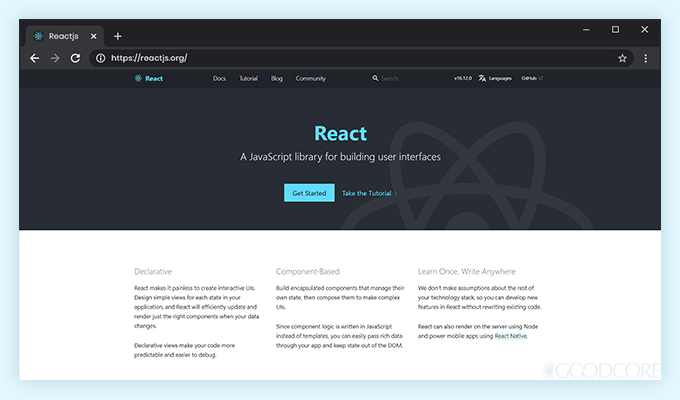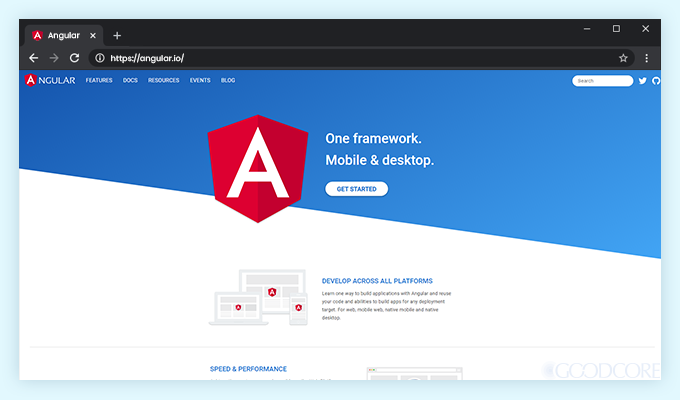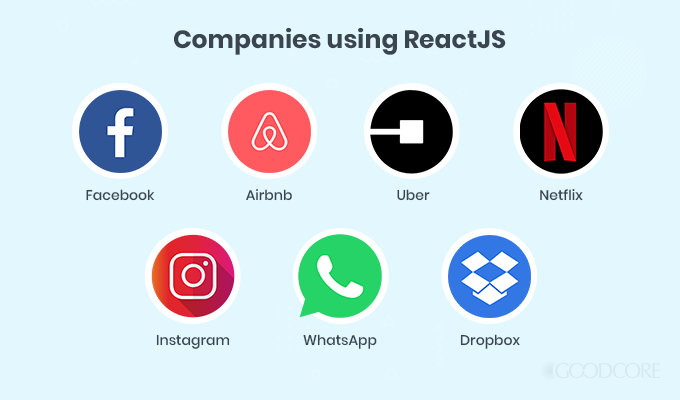Today we talk about two big players in the web development game: ReactJS vs Angular. With the constant evolution of JavaScript frameworks like ReactJS and Angular, the stakes are being set higher and higher. Frequent updates, the launch of new features, and increasing ease of use – these front end development frameworks go neck-and-neck to increase their market share. And today, developers are spoiled for choice when it comes to selecting a front end framework for JavaScript development. However, despite the increasing number of frameworks, the market remains dominantly shared by the two key names: React and Angular.
The debate of React vs Angular is an age-old one that recommences every year as they come out with an improved and updated version of their software. But is there a clear answer to the React vs Angular debate? Well, you can’t really say unless you understand both React and Angular in-depth, comparing every feature, pro, and con closely to determine who wins the React vs Angular’s battle for the top front-end development framework.
So let’s find out in this article the similarities and differences between React and Angular. So far, we know what React and Angular are: front-end development frameworks. But what does that mean? Let’s figure it out.
What Is ReactJS?

The basic difference between Angular and React lies in the way they are defined. ReactJS was developed and launched in 2013 by Facebook as a Javascript library for building user interfaces. Having an interactive user interface is an essential component of the frontend development of applications, and ReactJS helps you build it. It is a library that you can use to determine how your application is going to look like for users and how they would interact with it. In other words, as per the Model-View-Controller framework, ReactJS produces the ‘view’ of applications, which we will discuss in detail later.
What Is Angular?

In comparison to ReactJS, Angular is defined as a complete framework for the web and mobile applications. It is built on TypeScript – a superset of Javascript – which allows Angular to spin code efficiently. Developed and maintained by Google, Angular is a full-fledged toolkit that provides everything you need to develop large-scale applications. Comparatively, ReactJS is a smaller piece of the overall puzzle, whereas Angular is a collection of all different puzzle pieces.
Backed by the name of tech giant Google, Angular is a front-end development framework chosen by numerous leading businesses, including Xbox, Forbes, BMW, and more. Madewithangular.com has a complete list of applications built using Angular if you wish to learn more about it.
It is important to note that the current version of Angular is also referred to as Angular 2 and upwards. It should not be confused with what AngularJS is – which is a different and older framework that has become increasingly unpopular and will not be officially supported by Google past June 2021. If you wish to learn more about AngularJS frameworks, what AngularJS is used for, and how it differs from Angular 2 and later version, you can refer to this comparative research. But for the purpose of our article, we have used the term Angular to refer to Angular 2 and subsequent versions only.
Angular vs ReactJS: The Library vs Framework Debate
The ‘Library vs Framework’ aspect is a major difference in the way these two top front-end development tools are defined. Let’s delve deeper and unpack further similarities and differences between Angular and React. We are going to compare them on the basis of architecture, Document Object Model, components, templates, performance, scalability, and various other factors so that you can decide which one is best for you, ReactJS or Angular. Since choosing the right toolset can make your development process quick and efficient, it is important that you must make the right choice.
ReactJS vs Angular – A Complete Comparison

1. Architecture
The architecture of technologies reflects on the way that they are built to function, and it is one of the most basic points of comparison. The same applies to the ReactJS vs Angular debate as well.
ReactJS
As briefly discussed before, in a Model-View-Controller (MVC) framework, ReactJS is responsible for the ‘view’ element of application development. Being a UI rendering library, ReactJS uses the written code or JSX – which we will discuss in-depth later – for every component of your application and renders it.
In simpler terms, ReactJS is a collection of pieces of code that you can use to start off with the basics of your software applications and quickly add and update their features. It does not force on the architecture of your apps and allows you a great deal of freedom during the development process.
Angular
In contrast to React, Angular is a complete MVC framework for front-end development, which means it dictates the entire architecture of your application. Unlike ReactJS, which you can use flexibly to add functions to your existing websites and apps, Angular offers minimal flexibility. The application you develop using Angular and its architecture would only remain limited within the scope of tools and features that Angular offers. Hence, it predominantly determines the architecture of your product.
2. Document Object Model (DOM)
If you are confused about choosing Angular or React, comparing the Document Object Model (DOM) of each of these technologies can be a deciding factor for you. For those of you who are not familiar with DOM, it is a programming interface that shows how a browser reads the objects and nodes in your HTML or XML documents. For ReactJS vs Angular comparison, they maintain DOM in a completely different manner to each other.
ReactJS
ReactJS maintains a virtual DOM which allows it to be lightning fast. It is a standout feature for ReactJS that makes it widely popular. Having a virtual DOM means that the programming interface of ReactJS works with two snapshots of your HTML document. One is an original snapshot while the other has your updated changes. While comparing the two snapshots it is able to find the difference in your code and virtually implements it without rewriting the entire HTML document. Consequently, it gives a significant performance boost to the application as it does not force the whole browser to repaint itself every time there is a change.
Angular
On the other hand, Angular has a regular DOM which, contrary to React’s virtual DOM, does not automatically identify the changes in a file to update the newly made changes. Instead, it updates the entire HTML structure every time a new change is made. This process of constant upgrades slows the performance of the application and adversely affects the user’s experience. You can think of it in terms of heavy apps that refresh every time you use a feature and take time loading information.
3. Templates
Different development technologies use different kinds of templates, the same is true for Angular JS and React JS as well. Let’s shed more light on this key difference.
ReactJS
The template used by ReactJS is called ‘JSX (JavaScript XML)’ which combines the JavaScript code and markup in one line of code to create user interfaces efficiently. JSX is an extension to JavaScript. It uses an HTML-like syntax where you can build components by combining code and markup, as shown in the example below.
Example: You create a variable name and use it within JSX by wrapping it in curly braces, leading to the following output.
const name = 'Reader';
const element = <h1>Hello, {name}. Welcome to GoodCore.</h1>;

The biggest advantage of using JSX is that it makes your React code simpler and easier to understand. It is also preferred because you only have to have a good command over JavaScript to be able to use it.
Angular
Angular, on the other hand, uses templates based on advanced HTML using Angular ng-if and ng-or directives. This means you will need to learn the proper HTML syntax in order to be able to write code in Angular. You can use template URLs for external templates or write in-line templates with Angular. However, with Angular, you will have to learn the advanced directives at some point to be able to extend the power of the HTML and make use of all the functions within Angular. For someone who has no experience working with this technology, it can be a major drawback as the syntax of Angular directives is complex and sophisticated.
4. Components
Components are pre-written units of code that make the process of adding functions easier. They are the most important things for ReactJS and Angular, as they both follow a component-based approach. However, there are some clear distinctions within the approach of ReactJS and Angular, which we will discuss in detail below.
ReactJS
ReactJS is a library for building and rendering components. It offers a number of free and paid UI components that you can use to add functions in your application easily. Besides that, you can also build such components using JavaScript. A great advantage of ReactJS’ component-based approach is that their UI tools are developed by the community, and their React portal is an excellent resource. React portal offers a myriad of free and paid UI components that you can easily use.
Angular
Unlike React, Angular is not only about components. Although it follows a component-based approach, it is a complete framework or platform with a comprehensive tool suite to help you easily develop modern, reactive, and component-driven apps. This means that it offers more solutions that simply create components such as routing, state management, form validations, and other tools that you need to develop large applications.
5. Data Binding
The differences in data binding form a central point in the ReactJS vs Angular discussion, and it can be simply summed up as a ‘one-way binding vs two-way binding’ argument. Let’s find out what it actually means.
ReactJS
ReactJS supports unidirectional data binding, or what is commonly known as one-way data binding. It means that data flows one way while synchronising the Model and View. In simpler words, it is only when you update the Model state that the change is rendered in the View (i.e., the UI) of the application. However, changing the UI element does not change the Model state. Hence data flows only one way – Model state to UI.
Angular
On the other hand, Angular’s data binding model is bi-directional, meaning that there is a two-way flow of data between the Model and the View. Unlike ReactJS, Angular automatically synchronises the Model and View when you introduce a change to the model state and/or the UI. When you change the Model state, it renders a change in the UI, and if you update the UI, it changes the Model state. The illustration below perfectly shows how continuous updates take place in the two-way binding process.

6. Performance
When choosing a front-end development technology, it is crucial for developers to evaluate how their decision will impact the performance of their application. Let’s break down the difference between ReactJS and Angular and see how ReactJS vs Angular compete when it comes to the performance of the applications built using these technologies.
ReactJS
It is well established that both ReactJS and Angular are great front-end development technologies equally capable of developing large-scale applications. So why use React instead of Angular? Well, developers around the world agree that there’s a major difference between ReactJS and Angular because of ReactJS’ ability to guarantee high performance. The virtual DOM feature of ReactJS allows its application to virtually update the changes without rewriting the entire HTML document. This renders updates much quicker, allowing lightning-fast performance regardless of the size of the application. This gives it a slight edge in the React JS vs Angular competition.
Angular
Although Angular is a complete front-end development framework, the regular DOM feature of Angular makes the application slow in performance, especially when compared to applications built using ReactJS. Angular is, therefore, best-suited for developing single-page applications (SPAs) that update a single view at a time. It offers lower performance with large and complex multi-faceted applications. However, like React’s virtual DOM, Angular also uses the Change Detection technique to optimise performance.
7. Scalability
When choosing Angular JS vs React JS, it is essential to keep the future scope of the project in mind. Building scalable applications that can easily adapt to changes in the size of the user base and features they offer is extremely important in today’s constantly changing world. Developers today seek front-end development solutions that would allow them to easily scale the application if and when needed in the future.
ReactJS
Being a frontend library, ReactJS in itself does very little when it comes to building scalable applications. Does this mean that apps written using React are not scalable? No. It means that scaling React applications requires you to rely on third-party tools and supporting integrations external to ReactJS.
Angular
As mentioned previously, Angular offers more than just component building: it includes additional tools like routing, state management, HTTPS, etc. which help you build large-scale apps. If you need to scale your existing application by adding features, Angular comes packed with all the core features that you may require. This makes Angular a top choice when it comes to developing scalable software solutions.
8. Learning Curve and Development Experience
The learning curve of a new technology and the level of development experience it requires is important for developers when choosing from a variety of available options. Especially if you are a beginner who is just starting out in the field of front-end development. So, if you are someone wondering “what should I learn, React or Angular?” the learning curve and development experience are important points of comparison for you.
ReactJS
As discussed above, the ‘Library vs Framework’ debate becomes central when understanding the learning curve of both ReactJS and Angular. Since ReactJS is just a library, it has a smaller learning curve, and you do not need to learn a great number of technical concepts to be able to use it.
Furthermore, ReactJS uses JSX (Javascript XML), which is fairly easy to learn if you have prior experience with writing code in Javascript. Its HTML-like syntax might require some getting used to, but once you get the hang of it, it is smooth sailing from there. This makes ReactJS a great choice for front-end development, even for novice developers who want to dip their toes in the development of applications and experiment with ReactJS.
Angular
Since Angular is a complete framework that offers multiple tools and solutions within itself, it means using Angular entails a steep learning curve. As a beginner, you will have to familiarise yourself with the Typescript language that Angular uses. You will also need to learn about all the rich topics that Angular comprises of, from components, templates, modules, and other basic concepts to the more complex ones like dependency injections, change detection, and RxJS. For newcomers, the sheer amount of learning required can be overwhelming. However, the documentation available on Angular’s official website and by the developer community are great resources to learn about the range of topics if one decides to go with Angular in the ReactJS vs Angular battle.
When to Use ReactJS: Pros and Cons
ReactJS is the right choice of front-end development technology for all kinds of small and large-scale projects due to the flexibility it allows to the developers. It is especially well-suited for projects that are being handled by a small and less experienced team of developers. Since React is easier to learn and offers flexibility and simplicity, it makes it a great fit for such projects. It is also great for building dynamic websites and single-page applications that require high performance and quick loading speed.
Take a look at the strengths and drawbacks of using ReactJS to figure out whether or not you should go for it.
Pros
- ReactJS has a simple design and uses JSX which makes it easy to learn and use, even for beginners.
- Owing to its virtual DOM, ReactJS offers fast performance for applications.
- Being a view library, React does not force on the specific architecture of your application.
- React allows you to tailor your stack as per your own project requirements by giving you the freedom to choose additional libraries.
- It is a more mature and older tool than Angular. Therefore, it has a larger user base along with wider community support.
- React is backed and supported by Facebook, which makes it a top choice for many leading businesses. See a list of popular companies that use ReactJS below.

Cons
- React is not a full-scale framework. Using React means you will have to use third-party community-managed modules for routing, state management, form validation, etc. when developing applications.
- React rolls out frequent updates, making it difficult to maintain the code and keep the documentation up-to-date.
When to Use Angular: Pros and Cons
When choosing a technology stack for your project, you should only choose Angular if you have a large-scale, complex development project that requires the use of all the complex functionalities. An example of this can be developing a dynamic website or a large-scale enterprise web app. We do not recommend using Angular for simple short-term projects such as landing pages or websites with static content since it would unnecessarily complicate the development process.
Here is a list of the pros and cons of using Angular to help you decide better.
Pros
- It offers all the features within its platform. Therefore, you do not need to use third-party community-managed modules.
- Angular CLI is a helpful feature to get you started with projects. It automates the development process, making every step easier for you.
- Bi-directional data-binding used by Angular keeps the data flow simple and easy.
- Angular offers extensive documentation and support to help you with all the necessary information.
- Angular is supported by Google, which makes it a trustworthy framework with potential for growth and innovation. A number of leading companies rely on Angular for their front-end development need, check out the list below.

Cons
- You need to learn TypeScript and have a thorough knowledge of template syntax to be able to use Angular.
- Some of the Angular features such as dependency injections and RxJS are sophisticated and require a more professional approach to be implemented. Therefore, it has a steeper learning curve.
- Applications built using Angular offer a comparatively slower performance due to the regular DOM used by Angular.
Conclusion
Here we are at the end of our ReactJS vs Angular comparison. Concluding all the different aspects discussed in the sections above, we can easily establish that both ReactJS and Angular are great JavaScript front-end development tools that you can use to develop large-scale applications. If you are a developer struggling to decide between ReactJS vs Angular, I hope our article has provided you with some clarity about the key features of each. We encourage you to test-drive both of these tools and figure out the best solution for yourself.





